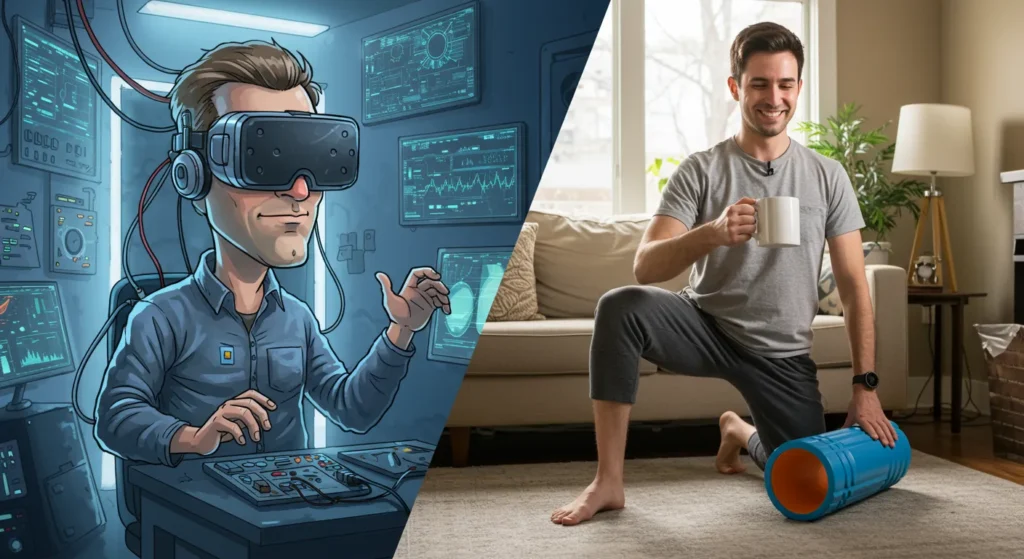Biohacking Tools: The Essential Toolkit to Affordable Biohacking

Picture this: you wake up feeling like you could conquer the world, your energy stays steady all day, and you fall asleep easily without scrolling your phone for hours. Sounds impossible? We used to think so too.
Three years ago, we were that couple – Giulia struggling with afternoon energy crashes, Federico battling poor sleep quality, both of us wondering why we felt “meh” despite eating well and exercising regularly. Then we discovered that biohacking tools don’t have to be expensive gadgets or complicated protocols. Sometimes, the most powerful changes come from simple, accessible tools that fit seamlessly into real life.
Today, we’re sharing our honest take on the biohacking tools that actually moved the needle for us – and the expensive mistakes we made along the way. Whether you’re curious about your first wearable tech purchase or wondering if that red light therapy panel is worth the investment, we’ve got you covered.
Biohacking Isn’t Just for Tech Bros: Our Down-to-Earth Approach
Let’s be honest – when most people hear “biohacking,” they picture Silicon Valley executives with $5,000 infrared saunas and morning routines that take three hours. That’s not us, and it probably isn’t you either.
We’re two Europeans who believe the best biohacking tools are the ones you’ll actually use consistently. Federico works in tech but still burns toast occasionally. Giulia loves her morning coffee ritual but isn’t about to give up pasta for some extreme diet protocol. We’re real people looking for real solutions.
What Biohacking Really Means in Daily Life
Here’s our definition: biohacking is simply using tools, techniques, and data to help your body and mind perform better. It’s not about perfection or expensive gadgets – it’s about small, sustainable improvements that compound over time.
Think of it like upgrading your phone. You don’t need the latest model with every feature, but a few key improvements can dramatically enhance your daily experience. The same applies to biohacking tools.
The best part? Many effective biohacking tools cost less than your monthly coffee budget. We’ve spent thousands testing everything from fancy HRV tracking devices to simple blue light blocking glasses, and we’ve learned that price doesn’t always equal effectiveness.
The Case for Low-Tech, Sustainable Hacks
Before we dive into specific tools, let’s address the elephant in the room: sustainability.
We’ve tried the complex morning routines, the multiple supplements, the perfectly optimized sleep environments. You know what we learned? The tools that stick are the ones that enhance your life rather than complicate it.
Our philosophy centers on three principles:
Start small. One new tool at a time, tested for at least 30 days before adding another.
Measure what matters. Data is only useful if it leads to actionable insights.
Keep it human. The best biohacking tool is worthless if it makes you feel disconnected from your natural rhythms.
Everyday Tools to Boost Energy, Focus, and Recovery
Now for the good stuff – the actual tools that have made a measurable difference in our daily lives. We’ve organized these by impact and accessibility, starting with the budget-friendly options that deliver surprising results.
Our Favorite Budget-Friendly Gadgets
Blue Light Blocking Glasses ($15-40)
Skeptical? So were we. But after tracking our sleep data for three months with and without these glasses, the difference was undeniable. Federico’s deep sleep increased by 23% when wearing them 2-3 hours before bed. Giulia noticed she fell asleep faster and woke up less during the night.
The key is getting glasses that actually block blue light effectively – many cheap options are just tinted and don’t do much. Look for glasses that block at least 90% of blue light in the 400-490nm range.
Water Intake Tracker (Free – $25)
This might sound basic, but proper hydration affects everything from cognitive function to energy levels. We started with a simple app-based water intake tracker, then upgraded to a smart water bottle that reminds us to drink.
The game-changer? Realizing that our afternoon energy crashes often correlated with dehydration, not blood sugar issues. Simple fix, massive impact.
This systematic review reveals that even mild dehydration can negatively impact cognitive performance, mood, and concentration, underscoring the importance of proper hydration.
Best Habit Tracker Apps ($0-10/month)
We’ve tested dozens of habit tracking apps, and our current favorite is a combination approach: a simple smartphone app for daily tracking plus a physical journal for weekly reviews. The best habit tracking app for us turned out to be one that sends gentle reminders without overwhelming notifications.
Meditation Apps ($5-15/month)
Finding the best meditation app for your personality makes a huge difference. Federico gravitates toward guided sessions with specific goals (focus, sleep, stress), while Giulia prefers nature sounds and open-ended meditation. We both use apps that track consistency rather than duration – five mindful minutes daily beats sporadic 30-minute sessions.
Non-Tech Habits That Make a Huge Difference
Sometimes the most powerful biohacking tools aren’t gadgets at all. These practices cost nothing but time and have delivered some of our biggest improvements:
Morning sunlight exposure: 10-15 minutes outside within an hour of waking. No special equipment needed, just consistency. This simple practice helped regulate our circadian rhythms better than any expensive light therapy device.
Temperature contrast: Alternating between warm and cold water in the shower for the last 2-3 minutes. It’s like a mini cold therapy session that costs nothing extra.
Breath work: Using specific breathing patterns during transitions between work tasks. No app required – just 4-7-8 breathing (inhale for 4, hold for 7, exhale for 8) repeated 3-4 times.
Our Personal Toolkit: What We Use and Why
Ready for the detailed breakdown? Here are the biohacking tools currently in our daily rotation, with honest reviews of what works and what doesn’t.
Tools That Fit Our Lifestyle
Best Sleep Tracker: Oura Ring vs. Whoop Band
We’ve tested both extensively. Our Oura Ring review after 18 months? It’s incredibly accurate for sleep tracking and recovery metrics, plus the battery lasts 4-7 days. The ring is discreet and provides actionable insights without overwhelming data.
The Whoop Band review is more complex. It excels at tracking strain and recovery for active individuals, but the subscription model and constant charging became annoying for us. If you’re training intensively, Whoop might be worth it. For general wellness tracking, we prefer the Oura Ring.
HRV Tracking Devices: The Reality Check
Heart Rate Variability tracking sounds impressive, but here’s what we learned: consistency in measurement matters more than the device itself. We use HRV tracking devices primarily to identify patterns over time, not to obsess over daily numbers.
The key insight? HRV drops when we’re stressed, under-slept, or fighting off illness – usually before we feel symptoms. This early warning system has helped us adjust our schedules and avoid burnout several times.
Best Glucose Monitor for Non-Diabetics
Continuous glucose monitoring was eye-opening, though we only recommend it for short-term experiments (2-4 weeks) rather than permanent use. The best glucose monitor showed us how different foods affected our energy levels individually – turns out Giulia handles carbs better in the morning, while Federico does better with protein-rich breakfasts.
Indoor Air Quality Monitoring
Our best indoor air quality monitor revealed that our bedroom CO2 levels were consistently too high, affecting sleep quality. Simple solution: cracking a window slightly or using a small fan for circulation. Sometimes the most valuable biohacking tools are the ones that identify problems you didn’t know you had.
Lessons from Experimenting as a Couple
Biohacking as a couple taught us that individual responses vary dramatically. The best smart ring for Federico might not work for Giulia. The optimal sleep temperature, meal timing, and exercise intensity differ between us, even though we share similar lifestyles.
This is why we always test new biohacking tools independently before making recommendations. What works for us might not work for you, and that’s completely normal.
Our Biggest Mistakes:
- Trying too many tools at once: We couldn’t identify which changes were actually helping.
- Focusing on data over feelings: Numbers are useful, but how you feel matters more.
- Expensive first purchases: Starting with budget options helps you understand what features you actually need.
Advanced Tools Worth the Investment
After establishing solid basics, some higher-end biohacking tools have proven worthwhile investments for us.
Red Light Therapy Panels
Our honest assessment of the best red light therapy panels? They’re expensive but effective for specific issues. We use ours primarily for muscle recovery after workouts and occasional skin health. The key is consistency – sporadic use won’t deliver results.
Look for panels with the right wavelength combination (660nm and 850nm) and sufficient power density. Many cheaper options don’t deliver therapeutic doses.
Outdoor Infrared Sauna vs. Indoor Options
We initially wanted an outdoor infrared sauna but space constraints led us to a portable indoor unit. Surprisingly, the indoor option worked better for consistency – we use it 3-4 times weekly versus the twice-monthly sessions we managed with gym saunas.
NMES Machine for Recovery
Neuromuscular Electrical Stimulation devices sound intimidating, but modern NMES machines are user-friendly and effective for muscle recovery. We use ours after intense training sessions or long travel days.
TDCS Device Experimentation
Transcranial Direct Current Stimulation is definitely advanced territory. We experimented with TDCS devices for cognitive enhancement but found the effects subtle and the protocols complex. Unless you’re deeply interested in neurostimulation, we’d skip this category.
Smart Home Integration
Best White Noise Machine
Sleep environment matters enormously. Our best white noise machine provides consistent background sound that masks traffic and neighbor noise. We chose a simple, reliable unit over smart-connected options that might malfunction or require updates.
EMF Protection Considerations
The best EMF protection for home use is often the simplest: distance from devices, airplane mode at night, and wired internet connections when possible. We tested various EMF protection products but found that basic habits delivered better results than expensive shielding devices.
Best Blood Pressure Machine for Home Monitoring
Regular blood pressure monitoring provides valuable health insights, especially when testing how different lifestyle changes affect cardiovascular health. The best blood pressure machine for home use should be validated for accuracy and easy to use consistently.
To find out which tools can truly make a difference in your daily routine, we invite you to read also our in-depth guide on the best biohacking tools.
Your Turn: Build Your Own Daily Biohacking Stack
Ready to start your own biohacking journey? Here’s our practical framework for choosing tools that will actually stick.
Choose One Area to Improve First
Don’t try to optimize everything simultaneously. Pick one area that’s currently affecting your quality of life:
- Energy levels: Start with sleep tracking and hydration monitoring
- Sleep quality: Begin with blue light blocking glasses and sleep environment optimization
- Fitness performance: Try HRV tracking or basic recovery tools
- Stress management: Focus on meditation apps and breathwork techniques
Spend 4-6 weeks testing tools in your chosen area before expanding to others.
Track Progress with a Simple Template
Create a simple daily tracking system that takes less than 2 minutes to complete. We use a combination of:
- Subjective ratings: Energy (1-10), mood (1-10), sleep quality (1-10)
- Objective metrics: From whatever device you’re testing
- Notes: Brief observations about what felt different
| Date | Energy | Sleep | Mood | Device Data | Notes |
| Day 1 | 6 | 7 | 8 | HRV: 42 | Tried new morning routine |
| Day 2 | 7 | 6 | 7 | HRV: 38 | Late meeting affected sleep |
This simple format helps identify patterns without becoming obsessive about data collection.
Start Small: Try These 3 Easy Wins This Week
Want to dip your toes into biohacking without buying anything? Here are three experiments you can start immediately:
Habit Stacking Made Simple
Pick one existing habit and add a small biohacking element:
- When you brush your teeth → Do 10 deep breaths
- When you sit down for lunch → Take a 2-minute mindfulness break
- When you get into bed → Put your phone in airplane mode
The key is attaching new behaviors to established routines rather than trying to create entirely new habits from scratch.
Creating Your Biohacking Space at Home
You don’t need a dedicated room – just a small area optimized for consistency:
- Charging station: Keep devices organized and charged
- Simple tracking tools: Journal, pen, water bottle
- Calm corner: Space for meditation, breathwork, or stretching
The goal is reducing friction for healthy behaviors while increasing friction for less helpful ones.
Our Weekly Planning Process
Every Sunday, we spend 15 minutes planning our biohacking focus for the week:
- Review last week’s data: What worked? What didn’t?
- Choose one small experiment: Something we can test consistently
- Set up success systems: Remove barriers to consistency
- Plan for obstacles: How will we maintain habits during busy days?
This planning process has been more valuable than any expensive gadget we’ve purchased.
Advanced Strategies That Actually Work
Once you’ve established basic consistency, these advanced approaches can accelerate your progress:
Seasonal adjustments: Your optimal biohacking tools might change with seasons, stress levels, or life circumstances. We adjust our sleep tracking, light exposure, and recovery protocols based on workload and seasonal light availability.
Partner accountability: Having someone else track similar metrics creates natural accountability without pressure. We share weekly summaries but don’t judge daily variations.
Regular tool audits: Every three months, we evaluate which tools are still serving us and which have become habits we no longer need to track actively.
Common Mistakes We See (And Made Ourselves)
Learning from our mistakes can save you time and money:
Expecting immediate results: Most biohacking tools require 2-4 weeks of consistent use before delivering noticeable benefits.
Over-relying on technology: The best fitness watch won’t help if you ignore its recommendations. Tools provide information; you provide the action.
Perfectionism paralysis: Waiting for the “perfect” setup prevents you from starting. Better to begin with basic tools and upgrade based on actual experience.
Ignoring sleep fundamentals: No amount of sleep tracking will help if your bedroom is too warm, too bright, or too noisy.
The Science Behind Our Recommendations
We base our tool recommendations on peer-reviewed research and personal experimentation. Key findings that shaped our approach:
Consistency beats optimization: Studies show that regular tracking of any health metric improves outcomes, regardless of the specific device used.
Placebo effects are real: Knowing you’re being monitored often improves behavior, which is actually a positive outcome.
Individual variation is enormous: What works for population averages might not work for you specifically.
That’s why we emphasize experimentation over strict adherence to protocols designed for other people.
Building Your Long-Term Biohacking Practice
The most successful biohackers we know treat it as a long-term practice rather than a quick fix. Here’s what sustainable biohacking looks like:
Tool cycling: Use intensive tracking for 4-6 week periods, then take breaks to avoid data obsession.
Gradual upgrades: Start with basic tools and upgrade based on actual usage patterns, not theoretical needs.
Focus on systems: The best biohacking tools support sustainable systems rather than relying on willpower or motivation.
Regular assessment: Monthly check-ins to evaluate what’s working and what isn’t serving your current goals.
Final Thoughts: Make It Work for Your Life
After years of testing everything from basic habit tracking apps to advanced TDCS devices, we’ve learned that the most powerful biohacking happens at the intersection of science and sustainability.
The best wearable tech won’t help if you don’t charge it regularly. The most accurate sleep tracker is useless if you ignore its recommendations. The perfect morning routine falls apart if it doesn’t fit your actual schedule.
Our advice? Start simple, be consistent, and upgrade gradually based on what you actually use. The biohacking tools that change your life are rarely the most expensive or impressive – they’re the ones that seamlessly integrate into your existing routines and provide actionable insights you can actually implement.
We help you feel better every day with practical, science-based strategies that truly work. That’s not just marketing speak – it’s our genuine commitment to sharing only the tools and techniques that have delivered real results in our own lives.
Ready to explore more of our tested strategies? Check out our comprehensive guides for more practical insights that bridge the gap between biohacking theory and real-world application.
Disclaimer: The information provided is for educational purposes only, not a substitute for professional medical advice. Always consult a healthcare professional.




